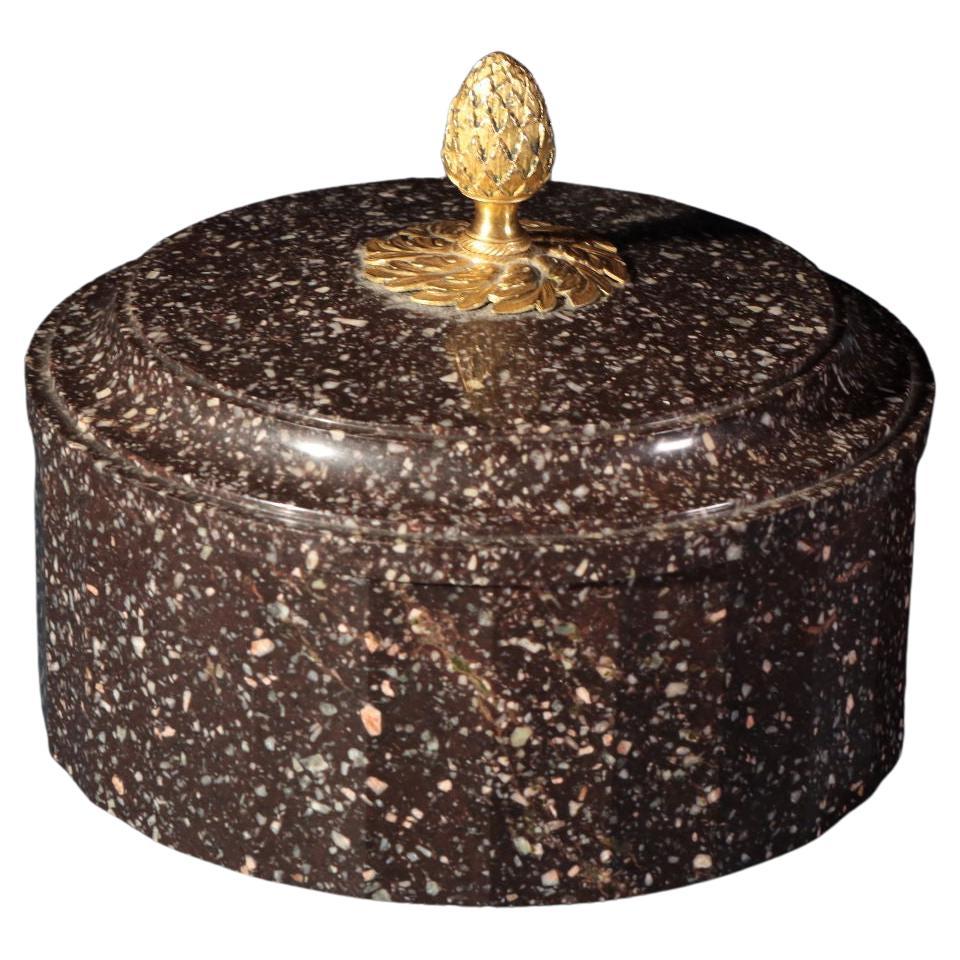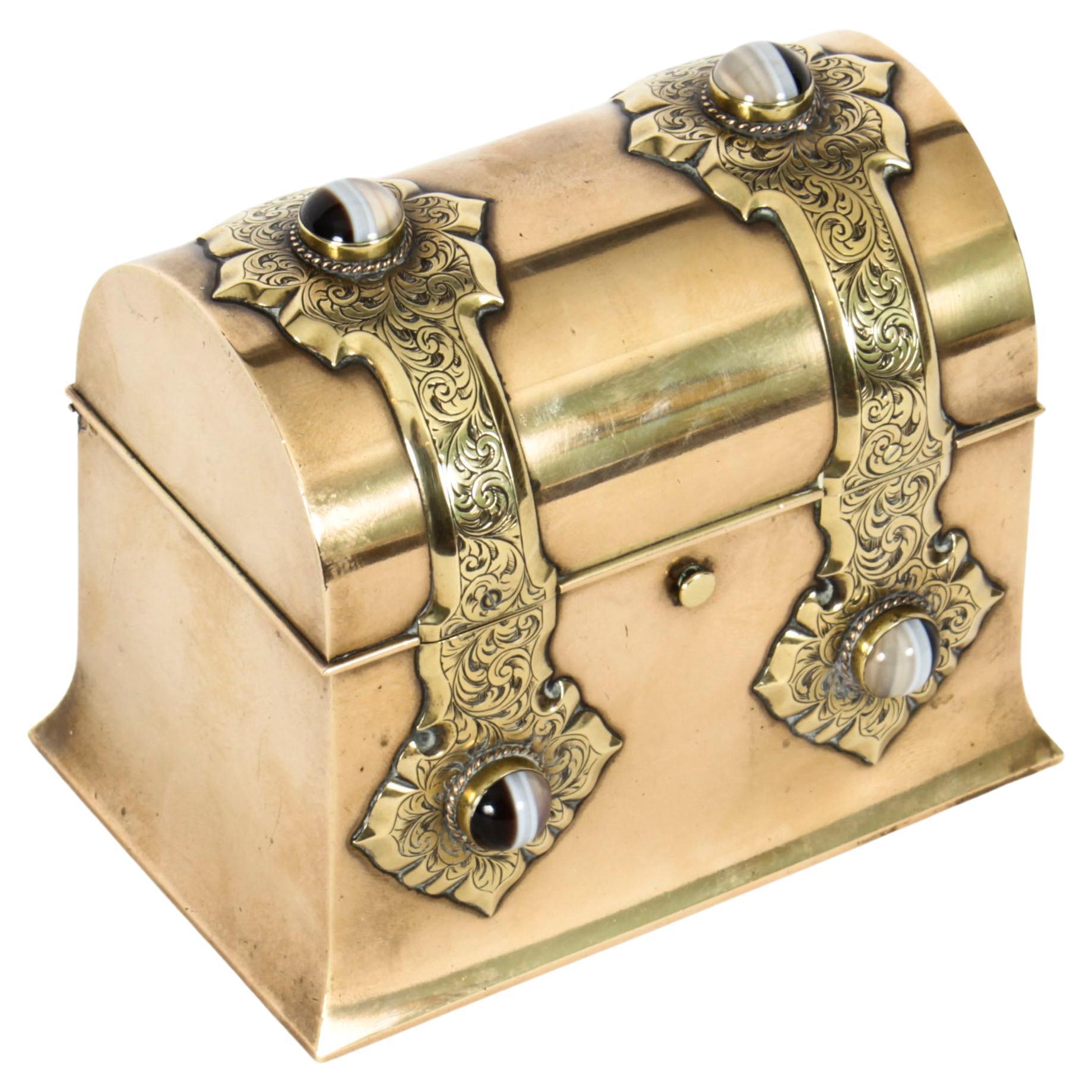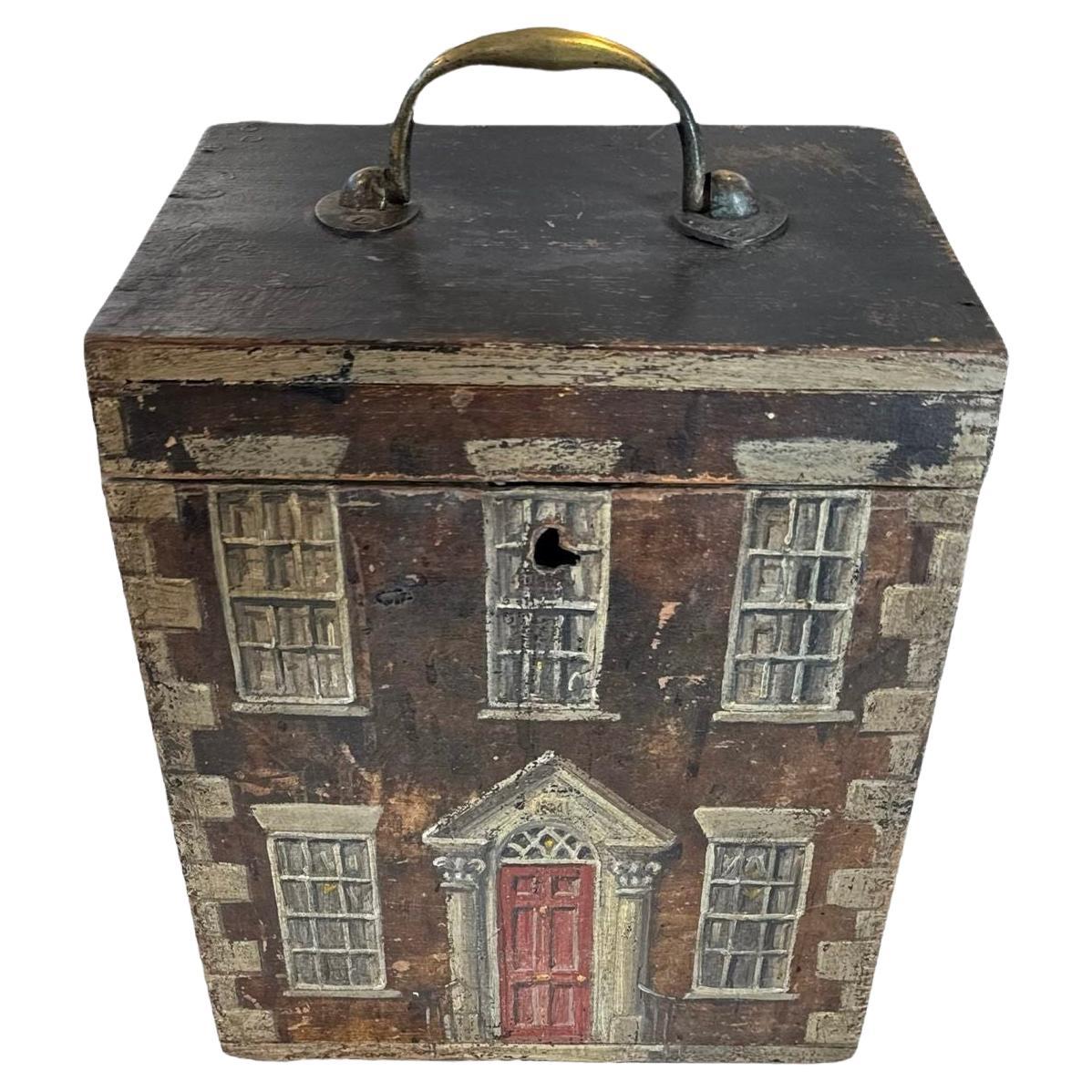Items Similar to An Ormolu Mounted Swedish Porphyry Butter Tub, Early 19th Century
Want more images or videos?
Request additional images or videos from the seller
1 of 12
An Ormolu Mounted Swedish Porphyry Butter Tub, Early 19th Century
About the Item
The delicately chamfered edges of the round tub and cover carved from Blyberg Porphyry with ormolu mounted acorn finial.
- Dimensions:Height: 4 in (10.16 cm)Diameter: 5 in (12.7 cm)
- Style:Empire (Of the Period)
- Materials and Techniques:
- Place of Origin:
- Period:
- Date of Manufacture:1810
- Condition:Minor chips to interior. Ormolu mount slightly patinated.
- Seller Location:Spencertown, NY
- Reference Number:
About the Seller
4.9
Vetted Seller
These experienced sellers undergo a comprehensive evaluation by our team of in-house experts.
Established in 1984
1stDibs seller since 2015
71 sales on 1stDibs
Typical response time: 1 hour
- ShippingRetrieving quote...Ships From: New York, NY
- Return PolicyA return for this item may be initiated within 14 days of delivery.
More From This SellerView All
- Pair of Sceaux Faux Porphyry Tobacco Jars, 19th CenturyLocated in Spencertown, NYThe pair of jars with covers with old repairs and chips.Category
Antique Early 19th Century French Empire Snuff Boxes and Tobacco Boxes
MaterialsFaience
- An English Painted Box resembling an early Georgian house, 19th CenturyLocated in Spencertown, NYA tromp l'oeil painted box in the manner of a georgian house. H. 10inches, W. 8 inches, D. 6.75 inches Good condition, but lacking lock.Category
Antique Mid-19th Century British Georgian Decorative Boxes
MaterialsBrass
- 11 Victorian Ormolu-Mounted Banded Orange Agate Snuff Boxes, 19th CenturyLocated in Spencertown, NYBoxes of varying shapes and sizes. Some round, oval, square and rectangular.Category
Antique 19th Century English Victorian Snuff Boxes and Tobacco Boxes
- Nine Victorian Ormolu-Mounted Black Banded Agate Snuff Boxes, 19th CenturyLocated in Spencertown, NYNine Victorian ormolu-mounted black banded agate snuff boxes. Some in oval and others in square shapes.Category
Antique 19th Century English Victorian Snuff Boxes and Tobacco Boxes
MaterialsAgate
- Swedish Porphyry Tazza, 19th CenturyLocated in Spencertown, NYThe turned base and stem with shallow bowl top. Shows signs of expert repair.Category
Antique 19th Century Swedish Neoclassical Centerpieces
- Empire French Pressed Wood Snuff Box, Early 19th CenturyLocated in Spencertown, NYThe circular lidded box depicting a woman reclining on a Recamier playing the harp. The underside with a star surrounded by banding with stippling decoration.Category
Antique Early 19th Century French Empire Snuff Boxes and Tobacco Boxes
MaterialsWood
You May Also Like
- Butter Casket Empire Bronze Porphyry Sweden \\\'800Located in Milano, ITCasket in Swedish porphyry, the faceted cylindrical body is equipped with a slightly rounded circular lid with spiral facets, with a pinecone-shaped gilded bronze grip and connected ...Category
Antique 19th Century Swedish Empire Decorative Boxes
MaterialsPorphyry, Bronze
- Large Italian Bronze Mounted Porphyry Casket, 19th CenturyLocated in New York, NYThe borders of the casket are mounted with varied stones including marble, agate and porphyry. Offered with a letter on the stationery of George W. Funk, dealers of Italian and Sp...Category
Antique 19th Century Italian Decorative Boxes
MaterialsAgate, Marble, Porphyry, Bronze
- Stunning 19th Century Kingwood Jewellery Box with Ormolu MountsLocated in Dublin, IEA stunning 19th century kingwood jewellery box with gorgeous ormolu dec-oration throughout, the moulded top of rectangular form beautifully quar-tered veneered and cross banded with ...Category
Antique 19th Century French Jewelry Boxes
MaterialsOrmolu
- Antique Ormolu & Agate Mounted Casket by Asprey, 19th CenturyLocated in London, GBThis is a superb antique gilt bronze and agate mounted casket by Asprey, Circa 1870 in date. The casket features a rectangular outline with domed lid which opens to reveal two clear glass scent bottles. It is stamped Charles Asprey, 166 Bond Street, Provenance: Lady Elizabeth Prinfle Lady in waiting to Queen Victoria, lived at Bonchurch, Isle of Wight It is a lovely piece which will make an unforgettable gift. Condition: In excellent condition having been beautifully cleaned in our workshops, please see photos for confirmation. Dimensions in cm: height 10.5 x width 12.5 x depth 7.5 Dimensions in inches: height 4 inches x width 5 inches x depth 3 inches Asprey was established in England in 1781 and founded as a silk printing business by William Asprey, it soon became a luxury emporium. In 1841, William Asprey's elder son Charles went into partnership with a stationer located on London's Bond Street. In 1847 the family broke with this partner and moved into 167 New Bond Street, the premises Asprey occupies today. From its central London location Asprey advertised 'articles of exclusive design and high quality, whether for personal adornment or personal accompaniment and to endow with richness and beauty the table and homes of people of refinement and discernment.' An early speciality was dressing cases. Asprey crafted traditional cases and designs, mostly in leather, suitable for the new style of travel ushered in by railways. The main competitors at the time were H.J. Cave & Sons. Asprey was recognised for its expertise when it won a gold medal for its dressing cases at the International Exhibition of 1862 but lost out to its rivals, H.J. Cave & Sons in 1867. The company consolidated its position through acquisitions. In 1859 Asprey absorbed Edwards, an award winning maker of dressing cases and holder of a Royal Warrant. The company also purchased the Alfred Club at 22 Albemarle Street, which backed on to the New Bond Street store and meant that Asprey now had entrances on two of London's most fashionable streets. In 1862, Asprey was granted a Royal Warrant by Queen Victoria. The Prince of Wales, later to be crowned Edward VII, granted another Royal Warrant. In 1953, for the coronation of Elizabeth II, Asprey paid homage with the Asprey Coronation Year Gold Collection, which featured a dessert, coffee and liqueur service in 18-carat gold and weighed almost 27 pounds. In April 1953, it went on show in the New Bond Street store and subsequently toured the United States. As the business grew, the company acquired manufacturing facilities and hired silversmiths, goldsmiths, jewellers and watchmakers including Ernest Betjeman, the father of the distinguished poet John Betjeman, one of the most highly regarded craftsman and designers of his day. In the twenties, commissions poured in from around the world, from American millionaire J. Pierpont Morgan to potentates such as the Maharaja of Patiala, who commissioned a huge teak travelling trunk for each of his wives in which each trunk was fitted with solid silver washing and bathing utensils with waterspouts of ornate tiger head and lined with blue velvet. Asprey cigarette cases became collectable amongst young sophisticates who delighted in its other modern products, including travel clocks, safety razors and automatic pencil sharpeners. Asprey Jewellery Asprey has a tradition of producing jewellery inspired by the blooms found in English gardens. Over the decades jewelled interpretations of flowers have evolved to include the Crown Daisy, Rose, Calla Lily and Lily Pad collections. The master diamond cutter Gabi Tolkowsky created the Asprey cut. The cushion cut gave Tolkowsky options for incorporating the Asprey "A" inscription around the edges of the stone. The result was the 61-facet Asprey cut, maximising light refraction to brilliant effect. The shape of the Asprey cut means that the cutting process can be done only by hand, unlike many other stones that involve machine cutting. Asprey Leather - the women's collection of clutches and handbags, such as those featured in the 1781 collection, come from crocodile, python and ostrich. The men's collection includes wallets, cardholders and travel watch cases crafted from lido, calf or alligator. Other items include the briefcases and backgammon boards. Asprey Silver - offers classic and whimsical contemporary silver pieces – such as the saltcellar fashioned to look like a cement mixer...Category
Antique 1870s English Decorative Boxes
MaterialsAgate, Ormolu
- Early 19th century Swedish carved oak lidded boxLocated in Debenham, SuffolkEarly 19th century Swedish carved oak lidded box circa 1800. Interesting find from one of our buying trips, naive carved/turned box made from solid oak. Still functional as an ever...Category
Antique Early 19th Century Swedish Rustic Decorative Boxes
MaterialsOak
- Antique Ormolu Mounted Pietra Dura Jewellery Cabinet 19th CLocated in London, GBThis is an absolutely fabulous antique French engraved ormolu and Pietra Dura mounted jewellery cabinet, Circa 1860 in date. The casket is in the form of a cabinet, with three fitte...Category
Antique 1860s French Decorative Boxes
MaterialsOrmolu
Recently Viewed
View AllMore Ways To Browse
Portmeirion Botanic Garden
Onyx Cigarette
Box With Garland
Thomas Pistor
Bear Black Compact
Russian Paper Mache Lacquer Box
Scottish Tartan Box
Wooden Box Danish
Pill Container
Mother Of Pearl Mother Of Pearl Furniture
Wedgwood Cut Steel
Wood And Brass Spice Box
Wooden Inlay Reuge
1914 Bronze And Milk Glass
1960 Teak Hinged Jewelry Box
20th Century Coconut Elephant Box
Ancient Roman Trinket Box
Antique Benedictine Bottle





